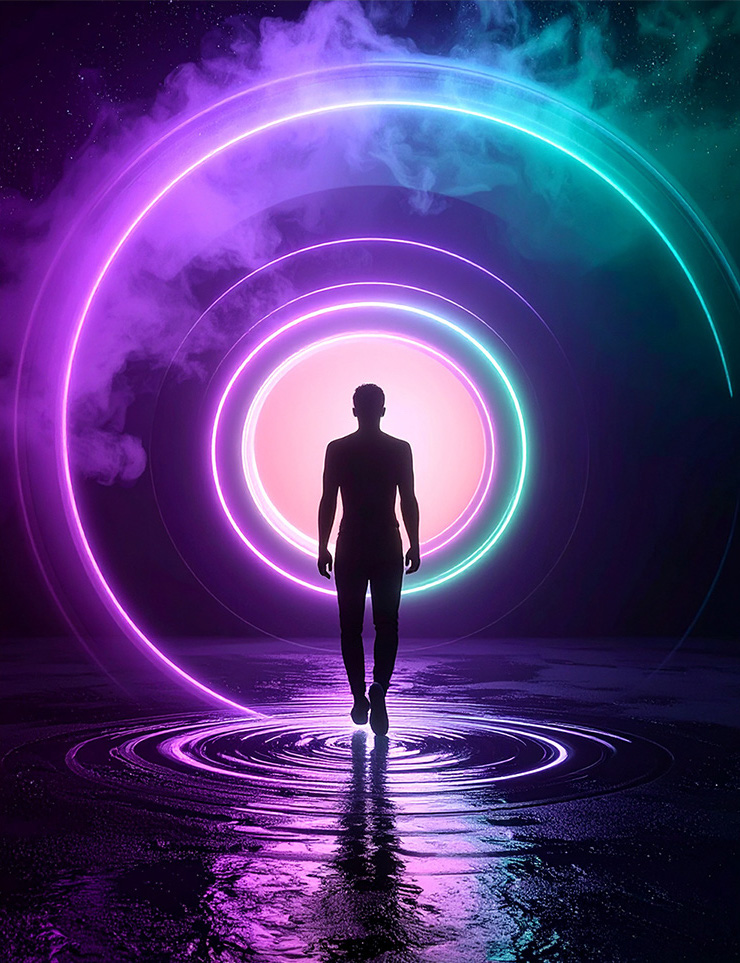A graphic showing a circular journey and infinite loop with a human silhouette in the middle. Layers of translucent pastel colors (soft lilac, mint green, pale peach), gentle curves and ripples, smooth gradients, subtle textures like frosted glass, calming atmosphere, minimalist aesthetic, horizontal orientation, original abstract art.
Adobe Firefly: Image Prompt
For decades, the AIDA model has been the bedrock of marketing and sales. Its straightforward, linear path—Attention, Interest, Desire, Action—has been taught in business schools and applied across countless industries. In the nonprofit world, it was adapted to be the quintessential fundraising funnel. You’d grab a potential donor’s Attention with a compelling story, pique their Interest with a specific need, build their Desire to make a difference, and then prompt the final Action: the donation.
But let’s be honest with ourselves, this model is a relic. It’s a transactional framework built for a different era. For you, the experienced fundraiser, it feels incomplete because it’s a one-and-one process. “AIDA is fundamentally flawed for philanthropy,” says Dr. Amelia Vance, a leading expert on donor psychology. “It views the donation as the finish line, when in reality, it’s just the starting gun for the real relationship.” The model neglects the most critical part of the process: what happens after the donation.
Why the Linear Fundraising Funnel is Failing Donor Retention
The single biggest pain point in our industry right now is donor retention. While we pour immense resources into donor acquisition—and the high acquisition costs that come with it—we’re seeing a significant portion of first-time donors never return. The old fundraising funnel 2024 approach is a leaky bucket. It assumes that once a donor has given, they’re simply “out” of the funnel.
The reality is that your donors aren’t just a list of transactions; they are partners in your mission. The traditional funnel fails to nurture that partnership. It focuses on the quantity of donors you can attract, not the quality of the relationships you build. This is a costly mistake. For you to build a sustainable organization, you need to think beyond the immediate donation and focus on lifetime value.
Introducing the New, Post-Donation Donor Journey
The modern donor journey isn’t a funnel; it’s a continuous loop. It accounts for the entire lifecycle of a supporter, from their first interaction to them becoming a true champion for your cause. This new model is based on a virtuous cycle of giving, engagement, and advocacy. Here’s how it works:
Awareness: This is where it all begins. A potential supporter learns about your organization. This could be through a social media post, a friend’s recommendation, or an online search.
Consideration: The individual is now exploring your work more deeply. They might visit your website, read your impact stories, or subscribe to your newsletter. They are asking: “Is this organization the right fit for me?”
Conversion: This is the critical moment. The supporter makes their first gift. The old model would call this “Action” and stop here. We know better. This is the pivot point where the loyalty loop begins.
Engagement: This is the post-donation experience. You’re showing the donor the impact of their gift. You’re inviting them to volunteer, join a webinar, or simply provide them with inspiring, non-ask content.
Advocacy: The final, and most rewarding, stage. The engaged donor becomes a loyal evangelist. They tell their friends about you, share your mission on social media, and are the first to respond to your calls for support. They have found that the classic AIDA model is an antiquated method for building a movement.
Building the Loyalty Loop: From Action to Advocacy
The key to mastering the new donor journey is to stop thinking about a funnel and start building a loyalty loop. This isn’t just a theoretical concept; it’s a series of deliberate, post-donation actions designed to transform a one-time giver into a lifelong advocate.
The Post-Donation Experience
The moment a donor hits that “submit” button, your work has just begun. The thank you is not a formality; it is a critical touchpoint.
Immediate Confirmation: Send an instant, personalized thank you email that feels like a warm hug, not a robotic receipt.
Beyond the “Thank You”: Use a short, dynamic video message or a quick call to express gratitude. You can use this to remind them that this gift has provided hope; it’s a beautiful thing.
Impact & Gratitude
After the initial thanks, you must show the donor the impact of their gift. This is what cultivates donor retention.
Concrete Examples: Don’t just say “Your donation helps.” Say, “Your $50 gift provided five hot meals and a warm blanket for families displaced by the storm.”
Ongoing Updates: Send regular, but not overwhelming, updates on the progress of the project they supported. Use photos and short video clips to make the impact tangible. The donor gave to you because they trust you, and your transparency builds upon that trust.
Ongoing Engagement
To keep the loop spinning, you need to offer opportunities for non-financial engagement. The goal is to make your donor feel like an insider, a true member of your community.
Surveys & Feedback: Ask for their opinion on your work. This shows that you value their voice, not just their wallet.
Volunteer Opportunities: Invite them to lend their skills. Volunteering deepens their connection to the mission.
Non-Ask Content: Share blog posts, stories, and educational resources that are relevant to your cause without asking for a single cent.
Cultivating Advocacy
This is the ultimate goal of the loyalty loop.
Easy Sharing: Provide pre-written social media posts, email templates, and other shareable content. Make it effortless for them to spread your message.
Ambassador Programs: Create a tiered program for your most loyal supporters, giving them exclusive content or early access to events.
Storytelling: Encourage donors to share their personal stories of why they support your mission. These authentic testimonials are your most powerful fundraising tool.
Practical Steps to Implement the New Donor Journey
Ready to put this into practice? Here is a step-by-step guide to transitioning from a linear to a looping fundraising funnel in 2024.
Map Your Current Journey: Start by listing every single touchpoint a donor experiences, from their first click to their last donation. Be honest about where the journey ends for most people.
Identify the Gaps: Look for places where you can add more “gratitude” and “impact” points. Are you thanking them a single time? What happens 30 days after the donation?
Build a Content Plan: Create content specifically for each stage of the new journey. This includes thank you videos, impact reports, and non-ask newsletters.
Automate Where Possible: Use your CRM to automate personalized thank you emails and follow-up communications.
Measure and Adjust: Track key metrics beyond just conversion rates. Look at repeat donation rates, unsubscribe rates, and social media engagement.
Conclusion
The classic AIDA model has had a good run, but it’s time to retire the linear fundraising funnel. The future of sustainable fundraising lies in the new, circular donor journey and the loyalty loop. By focusing on building deep, meaningful relationships after the donation, you can transform one-time givers into lifelong advocates. This isn’t just about raising more money; it’s about building a movement.
Start mapping your new journey today. Download our free worksheet to help you plot out your donor experience, from the moment of giving to advocacy.
Frequently Asked Questions (FAQ)
The AIDA model is a traditional, linear marketing and sales framework with four steps: Attention, Interest, Desire, and Action. It focuses on guiding a consumer to a single transaction, which in fundraising is the donation.
It’s a one-and-done model that considers the donation the final step. It fails to account for the crucial post-donation experience, which is where donor retention, loyalty, and long-term relationships are built.
The loyalty loop is a modern fundraising strategy that focuses on creating a continuous cycle of engagement and advocacy after a donor’s initial gift. It transforms a one-time giver into a lifelong advocate by consistently showing gratitude and impact.
Beyond just initial conversion, you should measure key metrics like your donor retention rate, the repeat gift rate from first-time donors, and non-financial engagement, such as social media shares or volunteer sign-ups.
The modern donor journey isn’t a funnel; it’s a continuous loop. It accounts for the entire lifecycle of a supporter, from their first interaction to them becoming a true champion for your cause.




